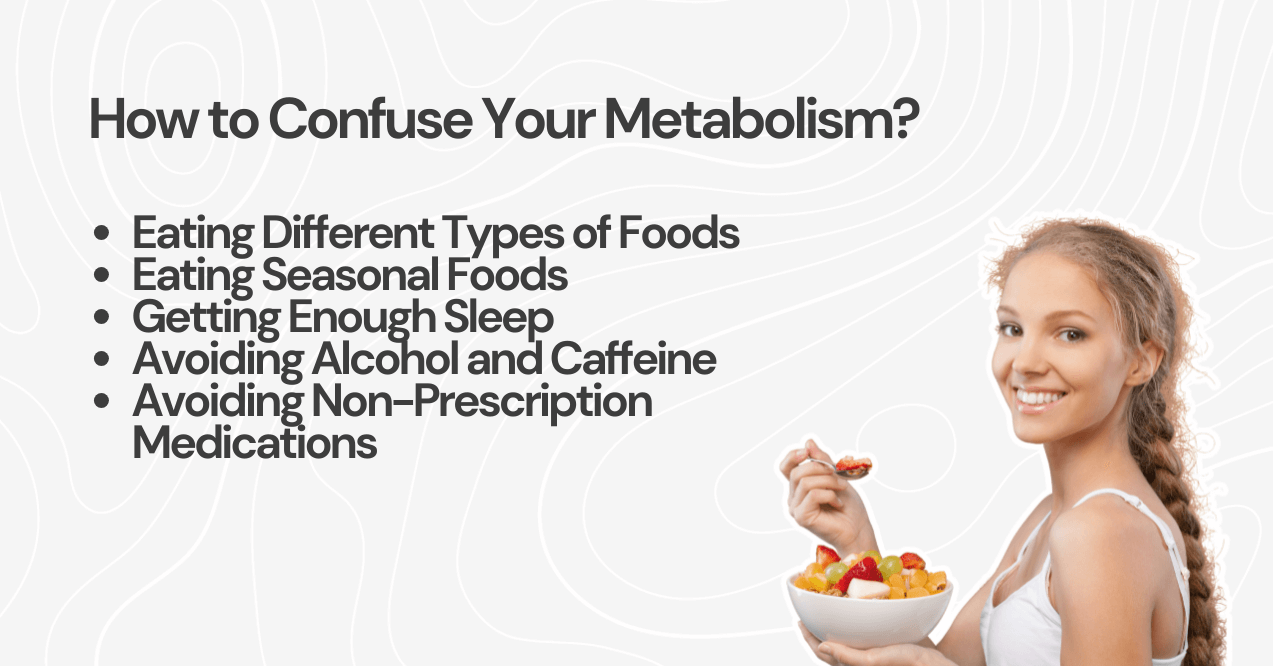7-Day Metabolic Confusion Diet Meal Plan
Ready to shake up your diet routine? The 7-day metabolic confusion diet might just be the game-changer you’ve been searching for! This trendy approach to eating aims to keep your metabolism on its toes by varying caloric intake and macronutrient composition.
The idea is to outsmart your body’s natural tendency to adapt to calorie restriction, potentially leading to more efficient fat burning and weight loss. To support your journey, consider incorporating superfood powders for added nutrients and essential vitamins, and performance supplements to help boost energy and maintain muscle mass during the diet. However, it’s important to note that while this strategy has gained popularity, scientific research on its effectiveness is still limited and the closest thing to it is intermittent fasting studies. If you’re curious about fasting’s potential role, our intermittent fasting calculator can provide insights tailored to your goals.
Moreover, if you’re wondering how to fuel your workouts while on this plan? Check out What to Eat Before a HIIT Workout for tips to maximize your energy and performance.
So, without further ado, let’s dive into the world of metabolic confusion and explore how it might revolutionize your approach to nutrition and weight management.
Key findings:

What Is a Metabolic Confusion Diet?
Ever feel like your body’s caught on to your dieting tricks? That’s where metabolic confusion meal plan comes in! This clever dietary strategy aims to prevent metabolic adaptation during calorie restriction by mixing up your caloric intake over time.
So, what is metabolic confusion? Think of it as keeping your metabolism guessing – one day you’re eating more, the next day less. This variation can occur daily, weekly, or even monthly, depending on the specific plan you follow.
The core idea behind metabolic confusion is to prevent your body from settling into a predictable pattern. When you consistently eat the same amount of calories day after day, your body adapts, potentially slowing down your metabolism to conserve energy.
By introducing caloric variability, the theory goes, you can keep your metabolism revved up and potentially enhance fat burning.
How to Confuse Your Metabolism?

Ready to give your metabolism a playful nudge? Here’s an easy explanation on how to do metabolic confusion diet effectively:
Eating Different Types of Foods
Variety is the spice of life – and your metabolism! Mix up your food choices to ensure a wide range of nutrients. One day, focus on lean proteins and veggies; the next, incorporate more complex carbs. This diversity not only keeps things interesting for your taste buds but also challenges your digestive system in different ways.
Consider experimenting with new cuisines or unfamiliar ingredients to broaden your nutritional horizons. Remember, each food group offers unique benefits, so aim for a colorful and varied plate at every meal.
Eating Seasonal Foods
Nature’s bounty changes with the seasons, and so should your plate! Seasonal eating ensures you’re getting a rotating cast of nutrients throughout the year. Plus, seasonal produce is often fresher and more nutritionally dense. Spring greens, summer berries, fall squashes, winter citrus – let the calendar guide your grocery list!
This approach not only supports local agriculture but also aligns your diet with nature’s rhythms. Seasonal eating can also be more cost-effective and environmentally friendly.
Eating Too Much or Too Little Food
Here’s where the “confusion” really comes into play. Alternate between higher and lower calorie days. On high-calorie days, you might aim for 2000-2500 calories, while on low-calorie days, you might target 1500-1800 calories. This fluctuation may help prevent your body from adapting to a set calorie level.
Pay attention to your hunger cues and energy levels during this process. It’s important to find a balance that works for your body and lifestyle, adjusting as needed.
Getting Enough Sleep
Don’t snooze on the importance of shut-eye! Adequate sleep is crucial for metabolic health. Aim for 7-9 hours per night. Poor sleep can throw off your hunger hormones and metabolism, potentially sabotaging your weight loss efforts.
Establish a consistent sleep schedule and create a relaxing bedtime routine. Consider limiting screen time before bed and creating a cool, dark sleeping environment to improve sleep quality.
Avoiding Alcohol and Caffeine
While a glass of wine or a cup of coffee might seem harmless, they can impact your metabolism. Alcohol can slow down fat burning, while excessive caffeine can interfere with sleep patterns. Moderation is key!
If you do consume these beverages, try to do so earlier in the day and in limited quantities. Consider herbal teas or infused water as alternatives to help you stay hydrated without disrupting your metabolic balance.
Avoiding Non-Prescription Medications
Some over-the-counter medications can interfere with your metabolism. Always consult with a healthcare professional before starting any new medication or supplement regimen, especially if you’re trying to manage your weight.
Be particularly cautious with diet pills or fat burners, as these can have unpredictable effects on your metabolism and overall health. Instead, focus on whole foods and natural approaches to support your metabolic health.
Metabolic Confusion Diet

Ready to put metabolic confusion into practice? Here’s a sample of a 7-day metabolic confusion diet:
Day 1 – High Calorie Day (2300 calories)
Focus: Protein and healthy fats
- Breakfast – Veggie and cheese omelet with whole grain toast
- Lunch – Grilled chicken salad with avocado and olive oil dressing
- Dinner – Baked salmon with quinoa and roasted vegetables
- Snack – Greek yogurt with berries and nuts
These meals provide a balance of complete proteins, complex carbohydrates, and healthy fats. Eggs offer choline and vitamin D, while salmon is rich in omega-3 fatty acids. Avocado and olive oil provide heart-healthy monounsaturated fats.
Day 2 – Low Calorie Day (1600 calories)
Focus: Fiber-rich foods
- Breakfast – Oatmeal with sliced banana and chia seeds
- Lunch – Lentil soup with a side salad
- Dinner – Grilled tofu stir-fry with brown rice
- Snack – Carrot sticks with hummus
This day emphasizes high-fiber foods to promote fullness and digestive health. Oatmeal and chia seeds are rich in soluble fiber, while lentils and brown rice provide complex carbs and additional fiber. Tofu offers plant-based protein.
Day 3 – Medium Calorie Day (1900 calories)
Focus: Complex carbohydrates
- Breakfast – Whole grain pancakes with fresh fruit
- Lunch – Turkey and avocado sandwich on whole grain bread
- Dinner – Lean beef stir-fry with mixed vegetables and brown rice
- Snack – Apple slices with almond butter
This day focuses on complex carbohydrates for sustained energy. Whole grains provide B vitamins and fiber. Lean turkey and beef offer protein and iron.
Day 4 – High Calorie Day (2400 calories)
Focus: Healthy fats
- Breakfast – Avocado toast with poached eggs
- Lunch – Tuna salad with olive oil-based dressing
- Dinner – Grilled steak with sweet potato and steamed broccoli
- Snack – Trail mix with nuts and dried fruit
This higher-calorie day emphasizes healthy fats to support hormone function and nutrient absorption. Avocados and olive oil provide monounsaturated fats, while tuna and nuts offer omega-3s. Sweet potatoes are rich in beta-carotene.
Day 5 – Low Calorie Day (1500 calories)
Focus: Lean proteins
- Breakfast – Protein smoothie with spinach and berries (check out our best green smoothie recipe if you need some inspiration)
- Lunch – Grilled chicken breast with mixed green salad
- Dinner – Baked cod with asparagus and lemon
- Snack – Hard-boiled egg with cherry tomatoes
This low-calorie day focuses on lean proteins to support muscle maintenance and satiety. Spinach adds iron and folate, while berries and tomatoes provide antioxidants. Cod offers omega-3 fatty acids. These meals require minimal preparation: blend smoothies, grill or bake proteins, and steam vegetables.
Day 6 – Medium Calorie Day (2000 calories)
Focus: Balanced macronutrients
- Breakfast – Greek yogurt parfait with granola and mixed berries
- Lunch – Quinoa bowl with grilled vegetables and chickpeas
- Dinner -Turkey meatballs with zucchini noodles and marinara sauce
- Snack – Cottage cheese with pineapple chunks
This day aims for balanced macronutrients, providing a mix of proteins, carbs, and fats. Greek yogurt and cottage cheese are high in protein and probiotics. Quinoa is a complete protein and rich in fiber. Zucchini noodles are low in calories and high in nutrients.
Day 7 – High Calorie Day (2500 calories)
Focus: Nutrient-dense foods
- Breakfast – Breakfast burrito with eggs, black beans, and salsa
- Lunch – Grilled shrimp skewers with brown rice and roasted vegetables
- Dinner – Lean pork tenderloin with roasted sweet potatoes and Brussels sprouts
- Snack – Smoothie bowl with açai, banana, and granola topping
This higher-calorie day emphasizes nutrient-dense foods. Black beans provide fiber and plant-based protein. Shrimp is a low-fat, high-protein option. Sweet potatoes are rich in beta-carotene, while Brussels sprouts offer vitamins K and C. Açai is packed with antioxidants.
Snacks are essential in the metabolic confusion diet, helping maintain energy and prevent overeating. Focus on nutrient-dense options aligned with daily calorie goals. Incorporate Greek yogurt, hard-boiled eggs, cottage cheese, nuts, avocado, chia seed pudding, fresh fruits, vegetable sticks with hummus, and whole grain crackers with nut butter. When considering metabolic confusion for weight loss it is essential to portion appropriately and vary choices for optimal nutrition.
When you complete this diet plan and want to try something different, check out our fast metabolism diet plan for more ideas.
Importance of Supplements while Dieting
When embarking on a diet, especially one that involves calorie restriction or significant changes in eating patterns, supplementation can play a crucial role in maintaining overall health and supporting your weight loss goals. While whole foods should always be the foundation of your nutrition, supplements can help fill nutritional gaps and provide additional support to your body during this transitional period.

One supplement worth considering is Trumeta Metabolic Reds, which harnesses the power of medicinal mushrooms to supercharge your immune health. This can be particularly beneficial when dieting, as calorie restriction may temporarily weaken your immune system. Trumeta Metabolic Reds works to make your immune system stronger, faster, and smarter at targeting invaders, providing the protection you need to stay healthy while pursuing your weight loss goals.
Pros And Cons Of The Metabolic Confusion Diet
Pros
- May prevent metabolic adaptation to calorie restriction
- Offers dietary variety, potentially reducing boredom and increasing adherence
- Can be customized to individual preferences and lifestyle
- May improve metabolic flexibility
- Could lead to more sustainable weight loss compared to constant calorie restriction
Cons
- Limited scientific research on long-term effectiveness
- May be complex to follow, requiring careful meal planning and calorie counting
- Potential for nutritional deficiencies if not properly balanced
- Could lead to disordered eating patterns in susceptible individuals
- May not be suitable for everyone, particularly those with certain medical conditions
Does Metabolic Confusion Work For Weight Loss?
The million-dollar question – does metabolic confusion actually work for weight loss? While the concept is intriguing, the scientific jury is still out. Some small studies have shown promising results, suggesting that calorie cycling may lead to greater weight loss compared to consistent calorie restriction.
For instance, a 2014 study published in the International Journal of Preventive Medicine found that participants following a calorie-shifting diet lost more weight and fat mass compared to those on a standard calorie-restricted diet.
However, it’s important to note that individual responses to any diet can vary greatly. What works for one person may not work for another. Factors such as age, gender, starting weight, activity level, and overall health can all influence how your body responds to metabolic confusion.
One potential benefit of metabolic confusion is its ability to prevent the metabolic slowdown often associated with long-term calorie restriction. By periodically increasing calorie intake, you may be able to keep your metabolism running more efficiently. You may also consider reading about vitamins to boost metabolism for a more effective approach.
It’s also worth considering that the success of any diet often comes down to adherence. If the variety and flexibility of metabolic confusion help you stick to your diet plan long-term, it may be more effective for you than a more restrictive approach.
Conclusion
In conclusion, metabolic confusion is a dietary strategy designed to prevent metabolic adaptation by varying caloric intake. By alternating between high, medium, and low-calorie days and incorporating diverse, seasonal foods, the approach offers a structured yet dynamic framework for eating. While it shows promise for enhancing metabolic flexibility and supporting sustainable weight loss, it also requires careful planning and may not suit everyone. Given the limited research on its long-term effects, individuals should consider their personal health needs and consult a professional before adopting this diet.
Alternate between high and low-calorie days throughout the week. Vary your macronutrient intake, focusing on different food groups each day. Incorporate a mix of proteins, complex carbs, and healthy fats. Stay consistent with meal timing. Monitor your body’s response and adjust as needed. Always prioritize nutrient-dense, whole foods.
Carb intake should vary daily in metabolic confusion. On high-calorie days, consume more complex carbs. On low-calorie days, reduce carb intake and focus on lean proteins and vegetables. Aim for 2-3 higher carb days per week, spacing them out. Always choose high-quality, fiber-rich carb sources.
While research is limited, some studies suggest metabolic confusion may aid weight loss by preventing metabolic adaptation. It can help maintain a higher metabolic rate compared to consistent calorie restriction. Individual results vary. Its success often depends on adherence and overall lifestyle factors. Consult a healthcare professional before starting.
Advertisement. This site offers health, wellness, fitness and nutritional information and is designed for educational purposes only. You should not rely on this information as a substitute for professional medical advice, diagnosis, or treatment. If you have any concerns or questions about your health, you should always consult with a physician or other health-care professional. Do not disregard, avoid or delay obtaining medical or health related advice from your health-care professional because of something you May have read on this site. The use of any information provided on this site is solely at your own risk.
Advertisement. This site offers health, wellness, fitness and nutritional information and is designed for educational purposes only. You should not rely on this information as a substitute for, nor does it replace, professional medical advice, diagnosis, or treatment. If you have any concerns or questions about your health, you should always consult with a physician or other health-care professional. Do not disregard, avoid or delay obtaining medical or health related advice from your health-care professional because of something you may have read on this site. The use of any information provided on this site is solely at your own risk.







